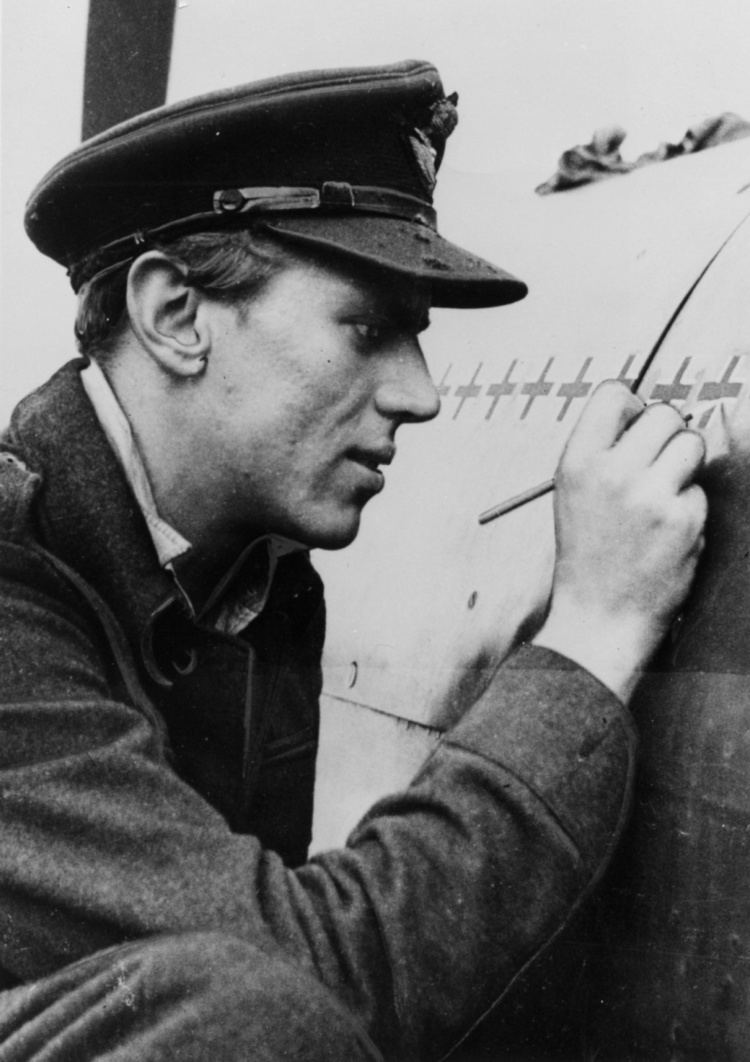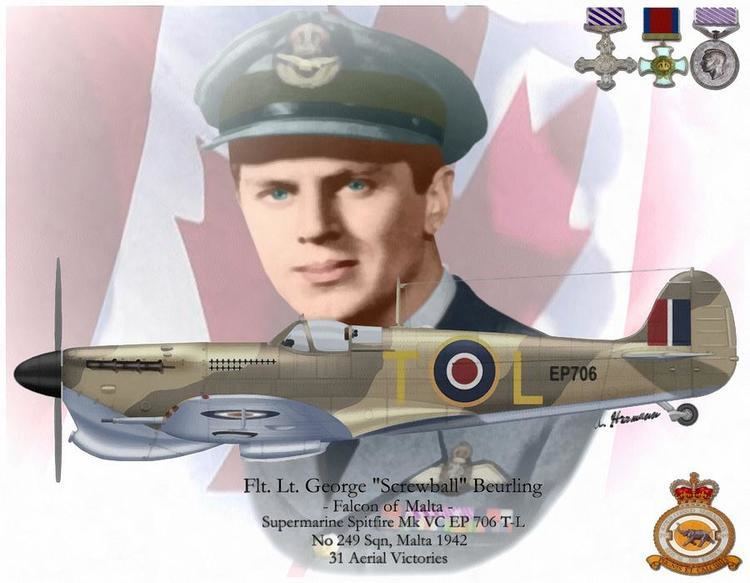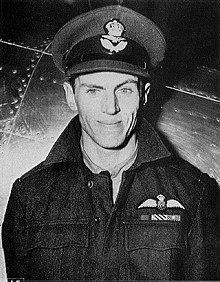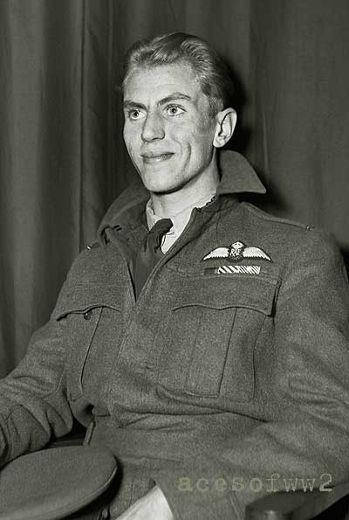Nickname(s) "Buzz""Screwball" Role Pilot Name George Beurling | Battles/wars World War II Battles and wars World War II Years of service 1940–1944 | |
 | ||
Service/branch | ||
Fliegende Helden des zweiten Weltkriegs-Teil 1:George Beurling-DOKU
George Frederick "Buzz" Beurling & Bar (6 December 1921 – 20 May 1948) was the most successful Canadian fighter pilot of the Second World War.
Contents
- Fliegende Helden des zweiten Weltkriegs Teil 1George Beurling DOKU
- George Beurling Canadas top WWII air ace
- Early life
- Second World War
- RAF service
- Malta 1942
- War bond drive
- Instructor
- Royal Canadian Air Force
- Discharge
- Death
- Legacy
- Summary of victory claims
- References

Beurling was recognised as "Canada's most famous hero of Second World War", as "The Falcon of Malta" and the "Knight of Malta", having been credited with shooting down 27 Axis aircraft in just 14 days over the besieged Mediterranean island. Before the war ended his official total climbed to either 31 or 31 1⁄3. Beurling's wartime service was terminated prior to war's end. In an attempt to continue combat flying in the postwar era, Beurling lost his life in a crash while attempting to deliver an aircraft to Israel.

George Beurling, Canada's top WWII air ace
Early life

George Beurling was born in 1921 in Verdun (now part of Montreal), Quebec into a religious family and was the third of five children in the family. His father, Frederick Gustav Beurling, was a Swedish and a commercial artist working for the Claude Neon Company. His mother, Hetty Florence Gibbs, is of English descent and was born in the Montreal suburb of Pointe-Saint-Charles. George Beurling began to develop an interest in flying at the age of 6 when his father built him a model aircraft. His parents wanted him to study in McGill University and become successful commercial artist just like his father. At the age of 15, he quit school and took up a job to increase his income. One year later, he had 150 flying hours and managed to pass all examinations for a commercial pilot license. Wanting to increase his flying experience, he went to China, hoping to join the Chinese Nationalist Air Force by crossing the US border. He was thinking to head to San Francisco and work for somewhile in China and later sign up for the job. Eventually, he was arrested as an immigrant at the border and was repatriated back home. He first took the controls of an aircraft in 1933 and was flying solo by 1938. He left school to work for an air freight company in Gravenhurst, Ontario, and soon gained a commercial license. Beurling joined the Royal Air Force in September 1940.
Second World War

With the outbreak of war, Beurling tried to join the Royal Canadian Air Force, but his lack of academic qualifications led to his rejection. He then tried to join the Finnish Air Force (which was fighting the Soviets in the Winter War), but could not get his parents' permission. Instead, Beurling sailed across the Atlantic on a convoy, landing in Glasgow, intending to enlist in the Royal Air Force. Unfortunately, he had forgotten his birth certificate and had to return to Canada. In September 1940, after he had survived the return trip, the RAF accepted him as a pilot.
RAF service

Having survived one or two aerial misdemeanours, Beurling reached No. 7 Operational Training Unit, at RAF Hawarden, in September 1941. Beurling demonstrated considerable skill in training. In Hawarden, he came under the influence of the great Ginger Lacey, whose score at the time stood at 27. Lacey later commented about Beurling: "There are not two ways about it, he was a wonderful pilot and an even better shot."
These two factors, coupled with exceptional eyesight, were the keys to Beurling's later success. But they did not come without effort. At Hawarden, he immersed himself in gunnery, estimation of range, deflection, bullet trail and bullet drop, imprinting them into his subconscious until they were automatic. For him, flying and shooting became one single action.
In the middle of December, he was posted as a Sergeant Pilot to 403 Squadron, a RCAF "Article XV squadron", which had just moved to North Weald, Essex. He flew his first (uneventful) combat mission, in a Supermarine Spitfire, on Christmas Day 1941. Beurling remained with 403 for nearly four months, escorting bombers and flying fighter sweeps across the English Channel. While he was in formations "jumped" by German fighters, Beurling did not get off an effective shot during his time with 403.
In early 1942, a change of policy by the RCAF required its squadrons to be staffed by RCAF personnel. Because Beurling had remained technically a member of the RAF, he was posted to 41 Squadron RAF in Sussex.
His first two missions with his new squadron were uneventful, but on the third, a sweep over Calais on 1 May, five Focke-Wulf Fw 190s jumped the section. Beurling, who was the "tail end Charlie", the last of the formation, became separated from his flight and his Spitfire suffered a number of serious hits that put half of his guns out of action. Nevertheless, he managed to fire a short burst at an Fw 190; the German fighter exploded in mid air. Two days later, as usual for a newcomer, he was assigned again to the number four position. He spotted a lone Fw 190, and broke from the flight to pursue it. He claimed the German fighter as destroyed over Cap Gris Nez. On this occasion, Beurling was reprimanded for attacking a target without permission, and became unpopular with his superiors and fellow pilots.
When another pilot was posted overseas, Beurling offered to take his place. Ordered to board a ship, he did not know his destination until the vessel reached Gibraltar. He was destined for No. 249 Squadron RAF, at Malta.
Malta (1942)
Fighter pilots played a critical role in the defence of Malta during its siege. Beurling landed on the island on 9 June, after having flown off the deck of HMS Eagle aboard his Spitfire, during Operation Salient. His nickname on Malta was "Screwball", an expletive he had a habit of using.
Beurling had his baptism of fire in the mid-morning of 12 June when, flying a Spitfire, with three other pilots from 249, the formation intercepted eight Bf 109s. Beurling claimed to have blown the tail off a Bf 109, but nobody saw it hit the ground, so he was credited with a "damaged". After that, Beurling claimed a series of kills that had no equal on the Mediterranean island. On 6 July 1942, with other pilots from 249, he attacked a formation of three Cant Z1007bis, 14 Reggiane Re.2001s and more than two dozen Macchi C.202s. He almost certainly shot down Sergente Francesco Pecchiari from 352a Squadriglia. Then he claimed another Macchi that crashed near Zejtun, likely the Reggiane of Sottotenente Romano Pagliani, 152a Squadriglia. He made a third claim that day, a Messerschmitt, hit from a distance of 800 yards and was credited with three victories in his first proper air battle at Malta.
On 10 July, Beurling's Malta tally rose to five in just four days, making him an ace. That day, it seems likely that he shot down the C.202 of Sergente Maggiore Francesco Visentini, from 378a Squadriglia.
On 12 July, Beurling, flying a Spitfire, and searching for pilot officer Berkeley-Hill, who was missing, spotted Tenente Colonnello Aldo Quarantotti and Tenente Carlo Seganti, flying Reggiane Re.2001s. Beurling, with Flying Officer Erik Hetherington, dived on the tail of the second of the two Reggianes and downed Seganti. Then Beurling attacked the other Reggiane. He closed up to 100 ft and just when Quarantotti spotted him, Beurling delivered a short burst that decapitated the Italian commander. This aircraft also fell into the sea. Two days later, he was badly shot up by Reggianes. Beurling's aircraft was "riddled by better than 20 bullets through the fuselage and wings". "An explosive bullet nicked my right heel", he recalled.
On 22 July, Beurling lost his best friend in Malta, French-Canadian Pilot Jean Paradis. The following day, eight 249 Spitfires were scrambled. Beurling claimed to have badly damaged a bomber and, after a long dogfight with a Reggiane, to have blown "his left wing off". The 151 Squadriglia, in fact, lost Serg Magg Bruno Di Pauli. The Macchi 202 pilot reported to have parachuted down after an AA shell had damaged his aircraft and realizing that he was followed by six Spitfires that, at the moment, had still not fired.
27 July was Beurling's "biggest day on Malta". That day, he shot down Sergente Faliero Gelli, and immediately after, Captain Furio Niclot Doglio, both flying Macchi MC. 202s, Regia Aeronautica's best fighter. Niclot Doglio, who was diving to counter attack the head-on Spitfires of 126 Squadron and had misunderstood the warning waggling of wings of his wingman, Maresciallo Ennio Tarantola (who had seen the oncoming 249 Squadron fighters from left, high above), was his 14th "kill".
On the same day, Beurling claimed also two Messerschmitt Bf 109 fighters, one of which was piloted by the ace Leutnant Karl-Heinz Preu of JG 53 although other sources attribute this to flak. On 24 July 1942, Beurling was awarded the Distinguished Flying Medal, the citation read:
Sergeant Beurling has displayed great skill and courage in the face of the enemy. One day in July 1942, he engaged a number of enemy fighters which were escorting a formation of Junkers 88s and destroyed one fighter. Later during the same day he engaged 10 enemy fighters and shot two of them down into the sea, bringing his total victories to eight.
On 30 July, he was commissioned as a pilot officer, and on 4 September won a bar to his DFM, largely for his exploits on 27 July. The citation read:
Since being awarded the Distinguished Flying Medal in July 1942, Sergeant Beurling has destroyed a further 9 enemy aircraft, bringing his victories to 17. One of his exploits was the destruction of 4 enemy fighters in one day; during these brief combats he also damaged a further 2 hostile aircraft. His courage and determination are a source of inspiration to all.
The enervation of daily combat combined with the effects of the poor rations and dysentery were telling. Beurling was bedridden for much of August and September, gaining only 1½ victories in August. On 8 August, while he was shooting at a Bf 109, he was jumped by two more. He claimed that he hit one and that it went straight into the sea. This was apparently confirmed by his section leader. But his aircraft was then hit in the engine and he belly-landed in a stone-walled field. "I climbed out, he recalled, unhurt except for a superficial cut in one arm." Beurling was shot down either by Herbert Rollwage or Siegfried Freytag and Fw Pohl of I./ JG 77, who all claimed a Spitfire shot down.
Beurling hitched back to Ta' Qali Field. On 25 September, he had another successful day, claiming to have downed three German fighters, but on this occasion his victories seem to be "overclaimed". That day, flying with 11 other Spitfires, he met a dozen Bf 109s 30 miles northeast of Zonqor Point. He claimed to have "disintegrated" a first Messerschmitt, to have damaged a second and put in flames a third, that "enveloped in flames, dived vertically striking the sea", the pilot bailing out. Two of these victims were two German fighters that came back to base, even if badly damaged and the third could be the one piloted by Kurt Gorbing, who made a forced-landing and died shortly after.
On 10 October, Beurling was testing his newly serviced Spitfire when he was vectored to intercept two Bf 109s, flying line abreast at 1,000 ft over Filfla. He reported to have hit the "starboard fellow" in the engine: "He pancaked right smack down on his belly and flipped over onto his back." The second BF 109 tried to fly away but he hit the gas tank: "The ship blow up, complete with pilot." Those "kills" brought Beurling's Malta tally to 21, plus another shared with two others. But there is no record of a Messerschmitt crashing on the island on 10 October 1942, nor any German losses. On the morning of 13 October, three miles north of St Paul’s Bay, Beurling, attacked a formation of JU 88s, escorted by 30 Bf 109s. He claimed to have at first hit a bomber, then an oncoming Bf 109 that burst into flames. Seconds later, he shot at a second Messerschmitt, without observing strikes, “but pilot bailed out”. On 16 October he was awarded the Distinguished Flying Cross, the citation read:
Pilot Officer George Frederick BEURLING, D.F.M. (128707) Royal Air Force Volunteer Reserve, No. 249 Squadron.
Since being awarded a Bar to the Distinguished Flying Medal, this officer has shot down a further 3 hostile aircraft, bringing his total victories to 20. One day in September 1942, he and another pilot engaged 4 enemy fighters. In the ensuing combat, Pilot Officer Beurling destroyed 2 of them. As a relentless fighter, whose determination and will to win has won the admiration of his colleagues, this officer has set an example in keeping with the highest traditions of the Royal Air Force.
Beurling was a committed Christian, teetotaler, and non-smoker; while his counterparts patronized the local bars every night, he dedicated himself totally to the art of aerial combat. Tending to be a loner on the ground and in the air, Beurling angered his commanders with his disdain for teamwork. His relentless concentration on aerial fighting led Beurling to develop a marked skill at deflection shooting and together with his "situational awareness", he was soon recognised as a deadly fighter pilot. Like many successful Spitfire pilots, Beurling developed the habit of only engaging enemy aircraft at 250 yards or less — a range at which many other pilots would be breaking away. Beurling owed his spectacular success to remarkably good eyesight and the ability to "toss his Spitfire" into violent combat manoeuvres. If jumped from behind, he would pull back on the stick of his Mk VC Spitfire so hard that the aircraft would enter a violent stall, flick over and spin. This was a hard, sudden and very dangerous act for the enemy fighter on his tail to follow. Beurling would also ram both ailerons and rudder into a sudden and violent turn, causing his Spitfire to flip over and drop like a stone. Only a very experienced (or crazy) pilot would pull such stunts more than once or twice. Beurling made them a matter of habit. He knew that the Spitfire could be nursed out of such self-induced trouble and get him home safely.
But Beurling was not invincible; he was shot down four times over Malta. On 14 October 1942 (his last flight over Malta), Beurling scrambled with six other pilots from his squadron to intercept a raid of Ju 88s escorted by 60 Bf 109s, Macchi 202s and Reggiane 2001s just south of Zonqor Point. He strafed a bomber that he claimed to have shot down, but was, in turn, hit by return fire from the Ju 88: “I picked up about 30 bullet holes.” Then he claimed to have damaged a Messerschmitt and to have blown the left wing of another Bf 109 off at the root. Seconds later, another German fighter hit him from below. He was wounded in the heel, elbow and ribs, and his Spitfire was set on fire. He managed to bail out into the sea. During this action, no Messerschmitt was in fact destroyed. Only 2 Staffel (Black 1/7619) of I/JG53, flown by Obfw Josef Edere who was wounded, was damaged in the action, and Edere crash-landed at San Pietro, Sicily. Beurling was probably shot down by Obfw Riker of 4/JG53 or Ltn Karl von Lieres of 2/JG27 (who was credited with his 26th). Of the seven Ju 88s claimed to have been shot down by the RAF, only one did not return. After his rescue, Beurling was hospitalised.
Beurling was then sent back to Britain on 31 October 1942. On the way, the B-24 transport aircraft he was aboard crashed into the sea off Gibraltar. Beurling was one of only three survivors.
On 4 November he received the Distinguished Service Order, the citation read:
Pilot Officer George Frederick BEURLING, D.F.C., D.F.M. (128707), Royal Air Force Volunteer Reserve, No. 249 Squadron.
Since being awarded the Distinguished Flying Cross, Pilot Officer Beurling has destroyed a further six enemy aircraft, bringing his total victories to 28. During one sortie on 13 October 1942, he shot down a Junkers 88 and two Messerschmitt 109s. The following day, in a head-on attack on enemy bombers, he destroyed one of them before he observed his leader being attacked by an enemy fighter. Although wounded, Pilot Officer Beurling destroyed the fighter. Then climbing again, although his aircraft was hit by enemy fire, he shot down another fighter before his own aircraft was so damaged that he was forced to abandon it. He descended safely on to the sea and was rescued. This officer's skill and daring are unexcelled.
Over Malta, he had claimed over 27 kills, by far the highest total by an RAF pilot during the campaign.
War bond drive
After landing back in Britain, Beurling was then sent to Canada to join a Victory Loan Drive, selling war bonds, being the guest of honour at a parade in Verdun and meeting Prime Minister Mackenzie King. He was promoted to war substantive Flying Officer (on probation) on 30 January 1943. He did not enjoy the war bond campaign. Also, he often said things that embarrassed the RCAF, such as that he enjoyed killing people. The leg wound Beurling had received over Malta, combined with his poor general health, returned him to hospital for several weeks. He completed his promotional work in mid-1943 and also met his future wife, Diana Whittall in Vancouver.
Instructor
Returning to Britain, Beurling was posted as a gunnery instructor to 61 OTU. On 27 May 1943, he was posted to the Central Gunnery School at RAF Sutton Bridge. On 8 June, during a mock dogfight, Beurling was forced to bail out of Spitfire II P7913 when the engine caught fire after being accidentally hit. It is alleged that whilst stationed at RAF Sutton Bridge he actually flew under the Crosskeys Bridge that crosses the Nene, which still stands today having been built 1897.
Royal Canadian Air Force
On 1 September 1943, Beurling transferred to the Royal Canadian Air Force, and was posted to an operational squadron, 403 (a return to his first squadron) at Kenley, flying the new Spitfire IX. Shooting down an Fw 190 of JG 2 in September, but unhappy with flying sweeps, Beurling requested command of a flight of North American P-51 Mustangs in order to carry out deep penetration, free-roaming raids into Germany. His request was turned down.
Disciplinary problems annoyed his commander, but Beurling was promoted to flight lieutenant. However, his stunting of a de Havilland Tiger Moth at zero feet over his airfield eventually led to his Wing Commander, Hugh Godefroy, threatening him with a court martial. Subsequently, Beurling was transferred to 126 Wing HQ and then to 412 Squadron.
At 412 Squadron, Beurling again came into conflict with his commander for stunting and his lack of teamwork, leading to his eventual grounding. He claimed his last kill on 30 December, shooting down and wounding Uzz. Wyrich of 5 Staffel, JG 26 flying a Fw 190, when the squadron was covering returning American bombers near Compiègne, France.
Discharge
Beurling returned to Canada in April 1944. He was given an honourable discharge in October and, despite an attempt to join the United States Army Air Forces, his wartime flying was over. He ended his career as a squadron leader with 31 and one shared official kills, nine claimed damaged, along with a DSO, DFC and a DFM and bar.
Death
Beurling's marriage ended in March 1945, but he was not formally divorced. He survived the war only to find himself unable to adjust to civilian life.
In 1948, Beurling was recruited to fly P-51 Mustangs for the Israeli Air Force. En route, after a test flight, Beurling fatally crashed his Noorduyn Norseman transport aircraft while landing at Aeroporto dell'Urbe in Rome.
It was his 10th crash. Suspicion at the time of the accident centred on possible sabotage, a theory which never was proven. "The initial report, while it identified the crew as Beurling and Leonard Cohen (another Malta RAF pilot), acknowledged that the bodies were burned beyond recognition." The funeral in Rome lacked only one element: Beurling's widow, family and personal friends were not in attendance. On a small brass plate over the lid of the coffin these words were written "Colonel Georgio Beurling".
Beurling's coffin was kept for three months in a warehouse in the Verano Monumental Cemetery, as nobody had claimed the body. Then his widow, Diana Whittall Gardner, had him buried in the Protestant Cemetery behind the Cestia Pyramid, between the graves of Percy Bysshe Shelley and John Keats. In November 1950, two and half years after his death, Beurling's casket arrived at Haifa Airport. His coffin, draped with the blue and white Israeli flag, was laid in a nearby air force base, where an honour guard of young airmen mounted a silent watch. During the long funeral in the streets of Haifa, Israeli Air Force aircraft paid homage to Beurling. At last, he was re-interred in the military cemetery at the foot of Mount Carmel. The grave is marked, as are the others in Israel Defense Forces cemeteries, with only name, serial number and rank: for Beurling that of segen, lieutenant.
According to Group Captain "Laddie" Lucas, Beurling was "untidy, with a shock of fair tousled hair above penetrating blue eyes. He smiled a lot and the smile came straight out of those striking eyes... he was highly strung, brash and outspoken... something of a rebel".
Legacy
Malta Spitfire, an account of his time in Malta, co-written by Leslie Roberts and Beurling, was first published in 1943.
"In Verdun the only reminder of the famous son is the boulevard which carries Beurling's name." Beurling Academy, a high school in the Lester B. Pearson School Board in Verdun, is also named after him.
Summary of victory claims
Beurling was provisionally credited with 31 air victories destroyed (and one third shared destroyed), and 9 damaged.
